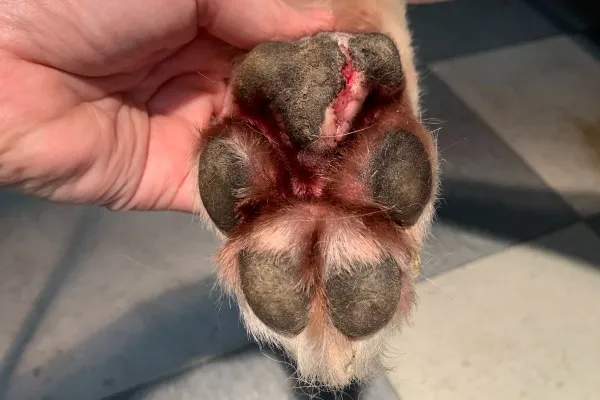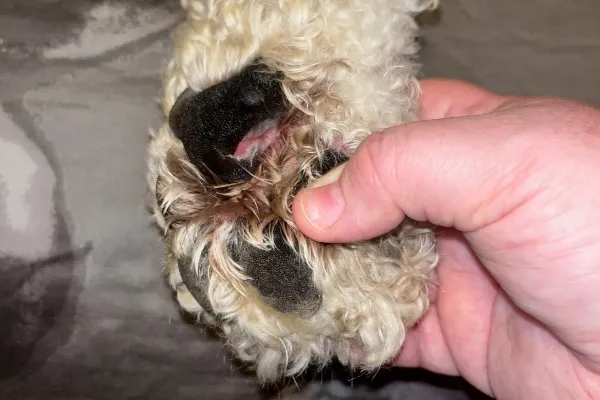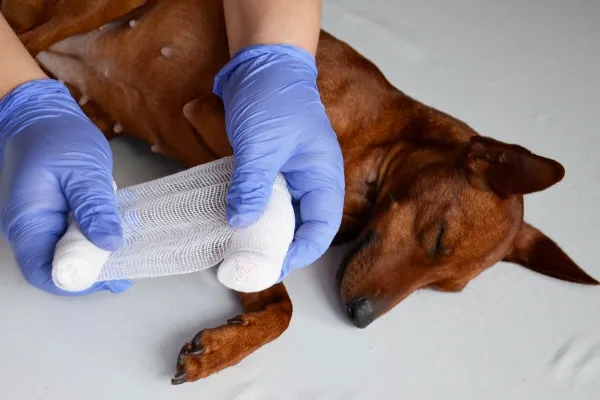Few things are as distressing as seeing your beloved canine companion in pain, especially when it comes to an injury as vital as a torn pad on a dog’s paw. Recently, Dr. Julie Buzby, an integrative veterinarian, shared a story about her client’s Labrador Retriever, April. April had stepped on broken glass during a walk, causing a paw pad injury. Thanks to previous “doggie first aid” training, April’s owner was able to gently remove the glass, clean, and bandage the paw before bringing her in for veterinary attention. Dr. Buzby commended the excellent first aid care, highlighting the importance of preparedness.
Not all dog parents have access to such training, and the suddenness of an injury can be overwhelming. This article aims to provide clear, step-by-step guidance on How To Treat A Torn Pad On A Dog, along with other common paw pad injuries. We’ll cover how to recognize symptoms, administer crucial first aid, understand veterinary care, and implement preventive measures to keep your dog’s paws healthy and happy.
Understanding Your Dog’s Paw Pads: Why They Matter
Have you ever considered just how much your dog relies on their paws? More than just feet, a dog’s paws are complex structures essential for their mobility and overall well-being. The muscles, bones, tendons, and ligaments all work in harmony, but it’s the paw pads that provide critical functions, ensuring your dog can walk, run, and play comfortably and securely.
Paw pads are composed of thick, fatty tissue, acting as natural shock absorbers. With every step, jump, or landing, these squishy pads cushion the impact, significantly reducing strain on the bones and joints of your dog’s feet. This protective layer is vital for long-term joint health.
Beyond cushioning, paw pads, in conjunction with toenails, offer essential traction. They help your dog maintain grip on various surfaces and navigate challenging terrains, from rocky trails to slippery floors. Furthermore, paw pads act as a natural barrier, protecting your dog from extreme temperatures – both hot and cold. Given their constant contact with the ground and exposure to diverse elements, understanding how to address a torn pad on a dog is crucial for any pet owner. Ensuring your dog’s paw pads are well-maintained and protected is a fundamental aspect of responsible pet ownership.
Common Types of Paw Pad Injuries in Dogs
Due to their constant exposure, paw pads are susceptible to a wide array of injuries. Knowing the different types can help you better identify and respond to what you might encounter.
Foreign Bodies (Punctures)
One of the most frequent paw injuries veterinarians see is a foreign object puncturing the paw pad. Sharp items such as broken glass, splinters, thorns, nails, or even fishing hooks can easily become embedded. These punctures can be deep, causing immediate pain and potentially leading to infection if not addressed promptly.
Cuts and Lacerations
If a sharp object doesn’t get lodged, it might instead cause a cut or laceration. These are common occurrences, as the paw pad’s primary role is to protect the underlying foot from dangerous elements. Cuts often happen when a dog steps on sharp debris. However, cuts can also arise from non-traumatic causes, such as severely dry paw pads that crack and split open, creating painful fissures. When you’re trying to figure out how to treat a torn pad on a dog, you’ll often be dealing with a form of cut or laceration.
 Close-up of a dog's paw pad with a fresh cut, indicating a common injury
Close-up of a dog's paw pad with a fresh cut, indicating a common injury
Flaps (Torn Pads)
Paw pad “flaps” are essentially more extensive and often more painful cuts. They occur when something slices the paw horizontally, partially detaching a section of the pad. This creates a loose piece of skin or tissue that can hang down or fold back over the exposed area. A severe cut that tears significantly can also lead to a flap. When your dog has a “torn pad,” it usually refers to this type of injury where a portion of the pad is separated, making each step pull on the loose tissue and causing considerable discomfort. This type of injury specifically requires careful attention and often professional veterinary intervention to ensure proper healing and to learn how to heal your dog’s paw pads.
Burns
Pad burns are unfortunately common, especially during warmer months. Surfaces like asphalt, concrete, or artificial turf can reach scorching temperatures, easily burning your dog’s paw pads. Even on a moderately warm day, pavement can be dangerously hot. Conversely, prolonged exposure to extreme cold, such as walking on ice, can also cause burns. Additionally, chemical burns can occur from contact with spilled caustic substances, or even from ice-melt products used in winter. Running for extended periods on abrasive surfaces can also cause friction burns.
Ingrown Toenails
Overly long nails can be a significant hazard. If not trimmed regularly, a dog’s toenails can curl under and grow into the paw pad, creating a painful puncture wound. This not only causes severe discomfort but also traps dirt and bacteria, significantly increasing the risk of infection. Regular nail trimming is a vital part of preventative paw care, preventing such painful and potentially infectious injuries.
Recognizing the Signs of a Paw Pad Injury
Identifying a paw pad injury early is crucial for prompt treatment. Dogs are masters at hiding pain, but paw pad injuries often produce visible or behavioral cues. If you suspect your dog has hurt their paw, look for any of the following symptoms:
- Sudden Lameness: Your dog may suddenly start limping or show an unwillingness to put weight on the affected paw. This can range from a slight hobble to completely holding the paw off the ground.
- Vocalization of Pain: Your dog might cry out, whimper, or yelp when attempting to put pressure on the injured paw.
- Excessive Licking or Biting: Dogs will instinctively try to clean or soothe a painful area. Persistent licking, chewing, or biting at the paw is a strong indicator of discomfort.
- Visible Bleeding: Any active bleeding from the paw pad, even minor, warrants immediate attention.
- Swelling: The injured paw or specific pad might appear swollen or puffy compared to the others.
- Discoloration or Reddening: The paw pad or the surrounding skin may look unusually red, inflamed, or discolored.
- Visible Wound: You might see an obvious cut, puncture, flap (torn pad), or burn. In some cases, a foreign object might still be embedded.
- Hair Discoloration: If there’s bleeding or discharge, the hair on the foot might be matted or discolored.
 Dog licking its paw, a common sign of pain or irritation from a paw pad injury
Dog licking its paw, a common sign of pain or irritation from a paw pad injury
If you observe any of these signs, carefully inspect your dog’s paw. Depending on what you discover, you may be able to provide immediate first aid before seeking veterinary care. A comprehensive approach to your dog’s health, including the consideration of products like best flea medicine for dogs without vet prescription, can contribute to their overall resilience against injuries and promote faster recovery.
First Aid for a Torn Pad or Other Paw Pad Injuries
Knowing how to treat a torn pad on a dog or other paw pad injuries with immediate first aid can make a significant difference in your dog’s comfort and recovery. Follow these steps carefully:
1. Assess Your Dog’s Overall Condition
First, approach your dog calmly and gently. Assess their demeanor. If your dog is in severe pain, they might react defensively, even if they’re normally very gentle. If your dog shows signs of aggression, extreme fear, or severe pain that prevents you from safely examining the paw, do not attempt further first aid yourself. Seek immediate veterinary care to avoid injury to yourself and further distress to your dog.
2. Carefully Examine the Injured Paw
If it’s safe to proceed, carefully inspect the entire paw. Look at the top, bottom, between the toes, and each individual paw pad. Determine the type of injury: Is it a cut, a puncture, a flap (torn pad), a burn, or is a foreign object visible? This assessment will guide your next steps.
3. Address Foreign Objects (If Safe) & Control Bleeding
- Removing Foreign Objects: If you see a small, superficial object (like a sliver or thorn) that is easy to grasp, you might gently remove it with clean tweezers. However, do not attempt to remove objects that are deeply embedded, large, or appear to be near a blood vessel, nerve, or joint. Doing so could cause further damage or severe bleeding. In such cases, leave the object in place and transport your dog to the vet immediately.
- Controlling Bleeding: If the wound is actively bleeding, apply gentle, firm pressure directly to the wound with a clean cloth or paper towel. Most minor cuts should stop bleeding within one to two minutes. If the bleeding is heavy, continuous, or does not stop after 10-15 minutes of direct pressure, this is an emergency. Contact your vet without delay.
4. Clean the Torn Pad or Wound
Once the bleeding is controlled, cleaning the wound is essential to prevent infection. Use cool, clean water to rinse the area. Cool water can also help reduce swelling and provide some pain relief, especially if the injury is a burn. You can also use a mild antibacterial soap or an antiseptic solution like diluted chlorhexidine or povidone-iodine (Betadine) to gently cleanse the area. As you clean, the wound might bleed slightly again; if so, reapply pressure until it stops.
5. Apply a Protective Bandage
Bandaging is crucial for keeping the wound clean, protected from further injury, and to contain any medication applied. If you don’t have proper bandaging materials, a clean towel or T-shirt can serve as a temporary wrap on the way to the vet. For a proper bandage, you’ll need sterile gauze pads, an absorbent layer (like cotton), and self-adhesive vet wrap.
Ensure the bandage is not too tight. You should be able to comfortably insert one to two fingers under the top edge of the bandage. Watch for signs that circulation is being compromised, such as swelling in the exposed toes (if applicable), or the foot feeling cool to the touch or discolored. A bandage that is too tight can cause more harm than good.
 Veterinarian carefully bandaging a dog's injured paw pad for protection and healing
Veterinarian carefully bandaging a dog's injured paw pad for protection and healing
6. Contact Your Veterinarian
Even if you’ve successfully administered first aid, it’s always important to follow up with your veterinarian. They can thoroughly examine the paw, ensure no further damage, prescribe pain medication or antibiotics if needed, and provide professional guidance on how to promote effective paw pad healing. While waiting for your appointment, continue to check and change the bandage daily, monitoring the wound for any changes or signs of infection.
Veterinary Evaluation and Treatment for Paw Pad Injuries
When you bring your dog to the veterinarian for a paw pad injury, they will perform a comprehensive assessment to ensure the best possible care.
How Your Vet Diagnoses a Paw Pad Injury
Your veterinarian will begin with a general physical examination, as sometimes other injuries might be present. They will then focus specifically on the injured paw. This involves a careful visual inspection for cuts, punctures, flaps (torn pads), burns, or other visible trauma. Your vet will also gently palpate and manipulate the bones and joints of the foot to check for underlying issues or fractures.
If there’s a suspicion of a deeply embedded foreign object (especially if not visible) or if they suspect bone involvement, your vet might recommend an X-ray. X-rays are excellent for identifying metallic objects and assessing the integrity of bones and joints, providing a clearer picture of the injury’s extent.
Professional Treatment Approaches for Torn Paw Pads
Once the diagnosis is made, your vet will tailor the treatment plan. This typically involves:
- Preparation: The hair around the injured paw pad may be carefully trimmed. This allows for better visualization of the wound, helps keep it clean, and prevents hair from getting trapped in the healing tissue.
- Wound Cleaning and Debridement: The wound will be thoroughly cleaned to remove any dirt, debris, or bacteria. If there’s a flap or torn pad, the vet might carefully trim away any non-viable or severely damaged tissue to promote healthier healing.
- Medication: Your veterinarian may apply an antibacterial ointment or a soothing cream to the wound. They might also prescribe oral antibiotics to prevent or treat infection, and pain medication to keep your dog comfortable during recovery.
- Bandaging: A professionally applied bandage is a cornerstone of paw pad injury treatment. Unlike simple first aid, vet bandages are often multi-layered and designed to:
- Control bleeding
- Protect the wound from contamination
- Prevent the dog from licking or chewing, which can delay healing or introduce infection (an Elizabethan collar, or E-collar, might also be recommended for this)
- Provide support and reduce movement
- Hold topical medications in place
It’s important to note that for deep cuts or torn pads, veterinarians often choose not to suture the paw pad closed. Paw pads are unique; they experience constant friction and movement, making stitches difficult to hold and often delaying rather than speeding up healing. Instead, careful cleaning, protection with bandaging, and diligent monitoring are usually preferred.
Your vet will provide detailed instructions on how often to change the bandage, what materials and medications to use, and when to bring your dog back for rechecks. Paw pad injuries can take time to heal due to the constant use of the foot, so patience and consistent follow-up care are crucial. Always contact your vet if you notice any signs of complications, such as increased swelling, redness, discharge, or if the bandage feels too tight.
Preventing Future Paw Pad Injuries
While some accidents are unavoidable, many paw pad injuries can be prevented with a few proactive measures. Incorporating these into your routine can significantly reduce the risk of your dog experiencing a torn pad or other painful foot trauma.
- Avoid Extreme Temperatures: Hot pavement, sand, or artificial turf can cause severe burns. Test the surface with the back of your hand for 7-10 seconds – if it’s too hot for you, it’s too hot for your dog. Similarly, prolonged exposure to ice or extremely cold surfaces can lead to frostbite or burns. Time your walks during cooler parts of the day or revise your routes to stick to grassy areas.
- Consider Protective Dog Booties: For walks in harsh conditions (hot pavement, icy sidewalks, rough terrain, or areas with chemicals like ice melt), protective dog booties can be invaluable. Products like PawZ dog boots are thin enough to allow dogs to feel the ground while offering a barrier against extreme temperatures and hazardous substances. Remember to remove them once inside to ensure proper circulation.
- Clean Paws After Walks: After walking in winter, or if you suspect your dog has walked through any chemicals, thoroughly wash their paws. This removes irritants like ice melt, salt, or other chemical residues that can cause dryness, cracking, or chemical burns.
- Inspect and Clear Walking Paths: Keep an eye out for potential hazards on your walking routes, such as broken glass, sharp rocks, discarded trash, or thorny plants. Choosing safer paths can prevent many injuries.
- Regular Nail Trims: Overly long nails can curl and grow into the paw pad, causing painful punctures and infections. Regular nail trimming is essential for paw health. If you are not comfortable trimming your dog’s nails, your veterinarian or a professional groomer can help.
- General Health and Parasite Control: A healthy dog is often a more resilient dog. Ensuring your pet receives adequate nutrition, regular exercise, and preventative care helps them maintain overall well-being. This includes managing parasites; while not directly related to paw pads, ensuring your dog is protected with appropriate treatments, such as chewable flea and tick options or over-the-counter flea and tick solutions, contributes to their overall vitality and ability to recover from any injury. For younger dogs, specifically, knowing about flea treatment for puppies can be part of their foundational health care.
- Post-Outdoor Inspection: After any trip outdoors, especially if you’ve been in areas known for foxtails or other plant hazards, carefully inspect your dog’s paws and entire body for any embedded foreign objects.
Be Prepared: The Importance of a Dog First Aid Kit
While these prevention strategies are incredibly helpful, accidents can still happen. Being prepared is your best defense. If you don’t already have a comprehensive dog first aid kit, now is the perfect time to assemble one for your home, and consider a smaller, portable version for your car or backpack. A well-stocked kit ensures you have the necessary supplies on hand to address minor injuries quickly and effectively.
Hopefully, your dog will never experience a paw pad injury. But if they do, remember to remain calm. With a well-prepared first aid kit and the steps outlined in this article, you can confidently provide initial care. Always remember that while you can offer immediate first aid for a torn pad on a dog, your veterinarian is your most valuable resource for advice and professional treatment. They can help manage your dog’s injury, ensuring your furry friend can return to their playful self in no time!
